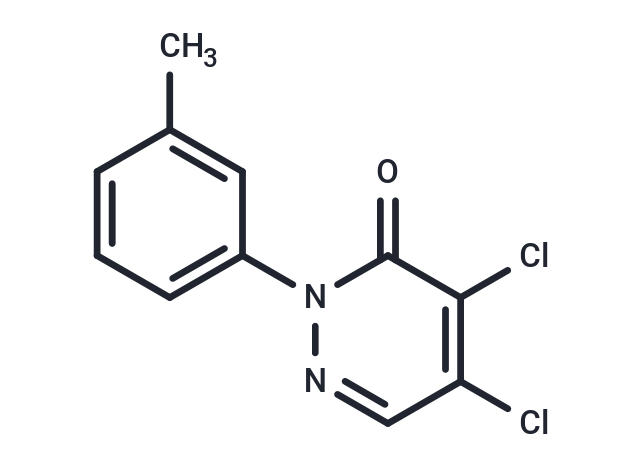Shopping Cart
Remove All Your shopping cart is currently empty
Your shopping cart is currently empty
LCS-1 is a selective superoxide dismutase 1 (SOD1) inhibitor and pyridazin-3-one derivative that displays trypanocidal activity at high concentrations.LCS-1 inhibits superoxide dismutase 1 inducing ROS-dependent death and degrading PARP and BRCA1 in glioma cells.

| Pack Size | Price | USA Warehouse | Global Warehouse | Quantity |
|---|---|---|---|---|
| 5 mg | $40 | In Stock | In Stock | |
| 10 mg | $73 | In Stock | In Stock | |
| 25 mg | $132 | In Stock | In Stock | |
| 50 mg | $193 | In Stock | In Stock | |
| 100 mg | $287 | In Stock | In Stock | |
| 200 mg | $428 | - | In Stock | |
| 1 mL x 10 mM (in DMSO) | $44 | In Stock | In Stock |
| Description | LCS-1 is a selective superoxide dismutase 1 (SOD1) inhibitor and pyridazin-3-one derivative that displays trypanocidal activity at high concentrations.LCS-1 inhibits superoxide dismutase 1 inducing ROS-dependent death and degrading PARP and BRCA1 in glioma cells. |
| Targets&IC50 | ANBL6-BR (bortezomib-resistant) cells:4.6 μM, normal human bronchial epithelial cells:2.66 μM, SOD1:1.07 μM, ANBL6-WT (bortezomib-sensitive) cells:2.5 μM |
| In vitro | LCS-1 (1-10,000 nM, 24 hours) exhibits selective cytotoxicity in HCT116 cells against cells with the BLM gene and BLM-deficient cells. [1] LCS-1 exhibited inhibitory effects on adenocarcinoma cell lines (e.g., H23, H2347, HCC827, median IC50 of 0.20 μM), whereas the IC50 for normal human bronchial epithelial cells (NHBE) was 2.66 μM.[2] In multiple myeloma (MM) cells, LCS-1 (0, 1.25, 2 μM, 4 h) significantly inhibited SOD1 enzyme activity in a concentration-dependent manner, and LCS-1 (0, 1.25, 2.5, 5 μM, 48 h) dose-dependently reduced the survival of several MM cell lines, including MM.1R (dexamethasone-resistant), Dox40 (adriamycin-resistant), and LR5 (melphalan-resistant) cell lines. In ANBL6-WT (bortezomib-sensitive) and ANBL6-BR (bortezomib-resistant) cells, the IC50 of LCS-1 treatment for 48 hours was 2.5 μM and 4.6 μM, respectively.[3] |
| In vivo | In vivo experiments, LCS-1 (20 mg/kg, intraperitoneal injection every other day for 14 days) significantly inhibited the growth of multiple myeloma and prolonged the survival of MM.1S-carrying mice. [3] |
| Synonyms | LCS1 |
| Molecular Weight | 255.1 |
| Formula | C11H8Cl2N2O |
| Cas No. | 41931-13-9 |
| Smiles | O=C1C(Cl)=C(Cl)C=NN1C2=CC=CC(=C2)C |
| Storage | Powder: -20°C for 3 years | In solvent: -80°C for 1 year | Shipping with blue ice/Shipping at ambient temperature. | |||||||||||||||||||||||||||||||||||
| Solubility Information | DMSO: 40 mg/mL (156.8 mM), Sonication is recommended. | |||||||||||||||||||||||||||||||||||
| In Vivo Formulation | 10% DMSO+90% Corn Oil: 2 mg/mL (7.84 mM), Sonication is recommeded. Please add the solvents sequentially, clarifying the solution as much as possible before adding the next one. Dissolve by heating and/or sonication if necessary. Working solution is recommended to be prepared and used immediately. The formulation provided above is for reference purposes only. In vivo formulations may vary and should be modified based on specific experimental conditions. | |||||||||||||||||||||||||||||||||||
Solution Preparation Table | ||||||||||||||||||||||||||||||||||||
DMSO
| ||||||||||||||||||||||||||||||||||||
| Size | Quantity | Unit Price | Amount | Operation |
|---|

Copyright © 2015-2026 TargetMol Chemicals Inc. All Rights Reserved.